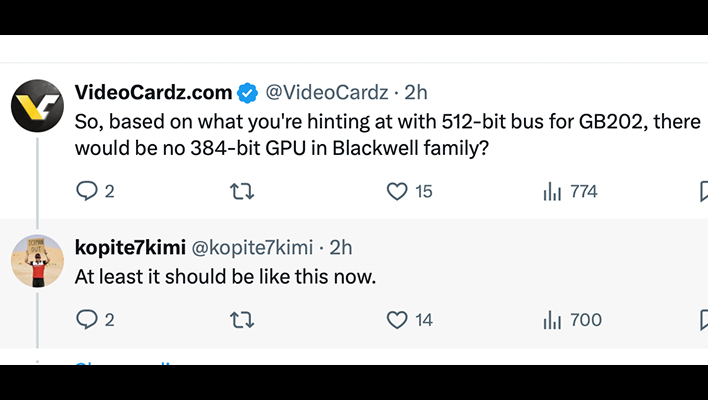NVIDIA's Next-Gen GeForce 50 Series Blackwell GPU VRAM Specs Allegedly Break Cover
According to popular leaker kopite7kimi on X, NVIDIA's Blackwell GPUs will have its VRAM memory bus skip 384-bit. The Blackwell GPUs will likely have its GB205 be 192-bit, and the GB203 256-bit. The possible top product, the GB202, will likely come in at a 512-bit memory bus width. One could speculate this could be the eventual GeForce RTX 4090 successor, such as the RTX 5090.

VRAM amount and memory bus have been a particularly poignant argument in modern GPUs, with specs seemingly being downgraded in some aspects in the GeForce RTX 40 series. The GeForce RTX 4070 Ti, for example, only had 12GB of VRAM at a 192-bit memory bus. This was looked begrudging upon by gamers who had to shell out the $799 MSRP for this high-end GPU, with a not-so-high-end memory configuration. While 1440P resolution in theory is fine for the most part, games that skew heavily on textures, ray tracing, path tracing, and other eye-candy can start to put a hurt on the paltry VRAM specs of the GeForce RTX 4070 Ti. Entering 4K is another challenge, as resolution ups the ante when it comes to hungry VRAM demands.
One can not also ignore the massive data center market that NVIDIA is currently swimming in, with what seems like perpetual demand for its products. Even consumer grade GeForce RTX 4090 GPUs have been stripped down to be used in AI data centers, due to its virtuosic 24GB of fast GDDR6X VRAM.
Add to the mix the potential blockbuster performance of a new family of GeForce RTX 50 series GPUs, and we could likely see those products poached from gamers' hands to be used for data centers. If the top end GB202 has a 512-bit memory bus, that may mean some impressive performance in VRAM intensive tasks. This will be true for high-end gaming and data centers that can't get more bespoke GPUs due to shortages.
The absence of a 384-bit memory bus does not signify much at this point, however. NVIDIA has been touting its AI such as DLSS 3 with frame generation, which in some ways can make lesser-spec GPUs perform above their pay grade. The existence of both 512-bit and 256-bit memory bus products at least show a healthy variety that will be good for gamers, but eventual confirmed specs will bear out if the products themselves satisfy.

